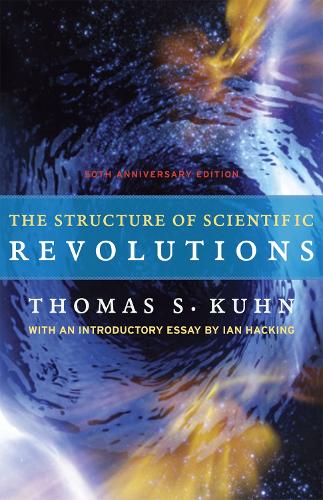The Structure of Scientific Revolutions

Ratings/reviews counts are updated frequently.
Check link for latest rating. ( 28,026 ratings, 1,692 reviews)Read More
Found a better price? Request a price match

The Structure of Scientific Revolutions
Book Hero Magic created this recommendation. While it's new and still learning, it may not be perfect - your feedback is welcome! IS THIS YOUR NEXT READ?
The Structure of Scientific Revolutions
Challenges long-standing linear notions of scientific progress, arguing that transformative ideas don't arise from the day-to-day, gradual process of experimentation and data accumulation, but that revolutions in science, those breakthrough moments that disrupt accepted thinking and offer unanticipated ideas, occur outside of normal science.
The Structure of Scientific Revolutions by Thomas S. Kuhn, with a contemporary introduction by Ian Hacking, is a seminal work that forever changed our understanding of how scientific progress occurs. Originally published in 1962, this profound book challenges the notion of science as a straightforward, incremental process of accumulation. Instead, Kuhn posits that significant scientific breakthroughs emerge not through gradual developments within the established framework of 'normal science', but through revolutionary shifts in paradigms—those intellectual upheavals that redefine and reshape our existing understanding of the world.
Kuhn's revolutionary idea introduced the concept of 'paradigm shifts', which occur when anomalies in scientific data accumulate to the point where the prevailing framework can no longer accommodate them. These shifts do not simply amount to new theories replacing old ones, but rather involve a transformation that alters the fundamental perspective and methodology of science itself. Such paradigm changes disrupt and revise our everyday reality, highlighting the non-linear nature of scientific evolution.
Even today, Kuhn’s insights hold remarkable relevance, especially as new scientific fields like biotechnology challenge existing norms, echoing the kinds of shifts he described. The book’s ongoing influence is evident across many scientific and academic disciplines, sparking debate and inspiring subsequent studies in the humanities and social sciences as well.
This redesigned edition includes a thoughtful introduction by philosopher Ian Hacking, who adeptly contextualises Kuhn’s ideas for modern readers. Hacking elucidates key terms such as 'paradigm' and 'incommensurability', offering clarity and contemporary relevance to Kuhn's original concepts. The introduction is strategically aligned with the book's sections, providing both historical background and insight into its ongoing applicability, making it an invaluable resource for scholars and enthusiasts alike.
Additionally, the edition features a newly expanded index, enhancing its utility for academic research and ensuring it remains a crucial resource for those eager to understand the dynamics of scientific inquiry and the nature of transformative scientific change.
Book Hero Magic summarised reviews for this book. While it's new and still learning, it may not be perfect - your feedback is welcome! HOW HAS THIS BEEN REVIEWED?
The Structure of Scientific Revolutions is acclaimed for introducing the concept of a "paradigm shift" in scientific progress. Reviewers praise its profound impact on understanding the history and philosophy of science, highlighting its influence across multiple disciplines. The book reshaped the perception of scientific discovery, underscoring the imperfections and evolution in scientific processes, and is regarded as a landmark in intellectual history.

Book Details
INFORMATION
ISBN: 9780226458120
Publisher: The University of Chicago Press
Format: Paperback / softback
Date Published: 30 April 2012
Country: United States
Imprint: University of Chicago Press
Edition: Fourth Edition
Audience: Tertiary education
DIMENSIONS
Spine width: 2.0mm
Width: 14.0mm
Height: 22.0mm
Weight: 340g
Pages: 264
About the Author
Thomas S. Kuhn (1922-96) was the Laurence Rockefeller Professor of linguistics and philosophy at the Massachusetts Institute of Technology. His books include The Essential Tension; Black-Body Theory and the Quantum Discontinuity, 1894-1912; and The Copernican Revolution.
No collection found for handle: uncategorised
Why buy from us?
Book Hero is not a chain store or big box retailer. We're an independent specialist on a mission to help more Kiwis rediscover a love of books and reading!

Service & Delivery
Our cozy 200m2 warehouse in Auckland holds over 10,000 books in-stock so you're not waiting for books to arrive from overseas.

Auckland Pick Ups
We're an online-only store but for your convenience you can pick up your order for free from our warehouse in Hobsonville.

Our Gifting Service
Books make wonderful thoughtful gifts and we're here to help with gift-wrapping and cards. We can even send your gift directly to your loved one.














